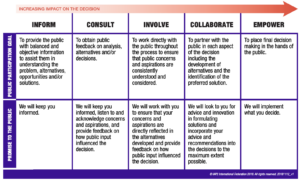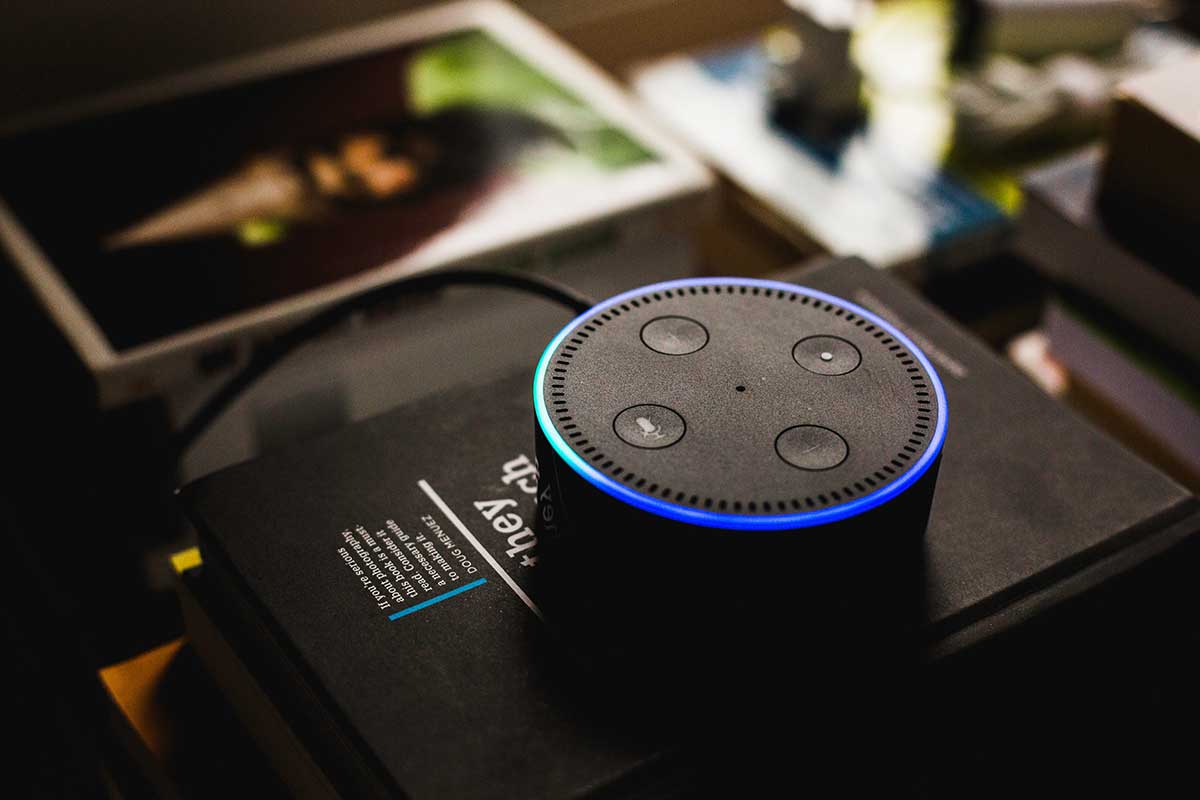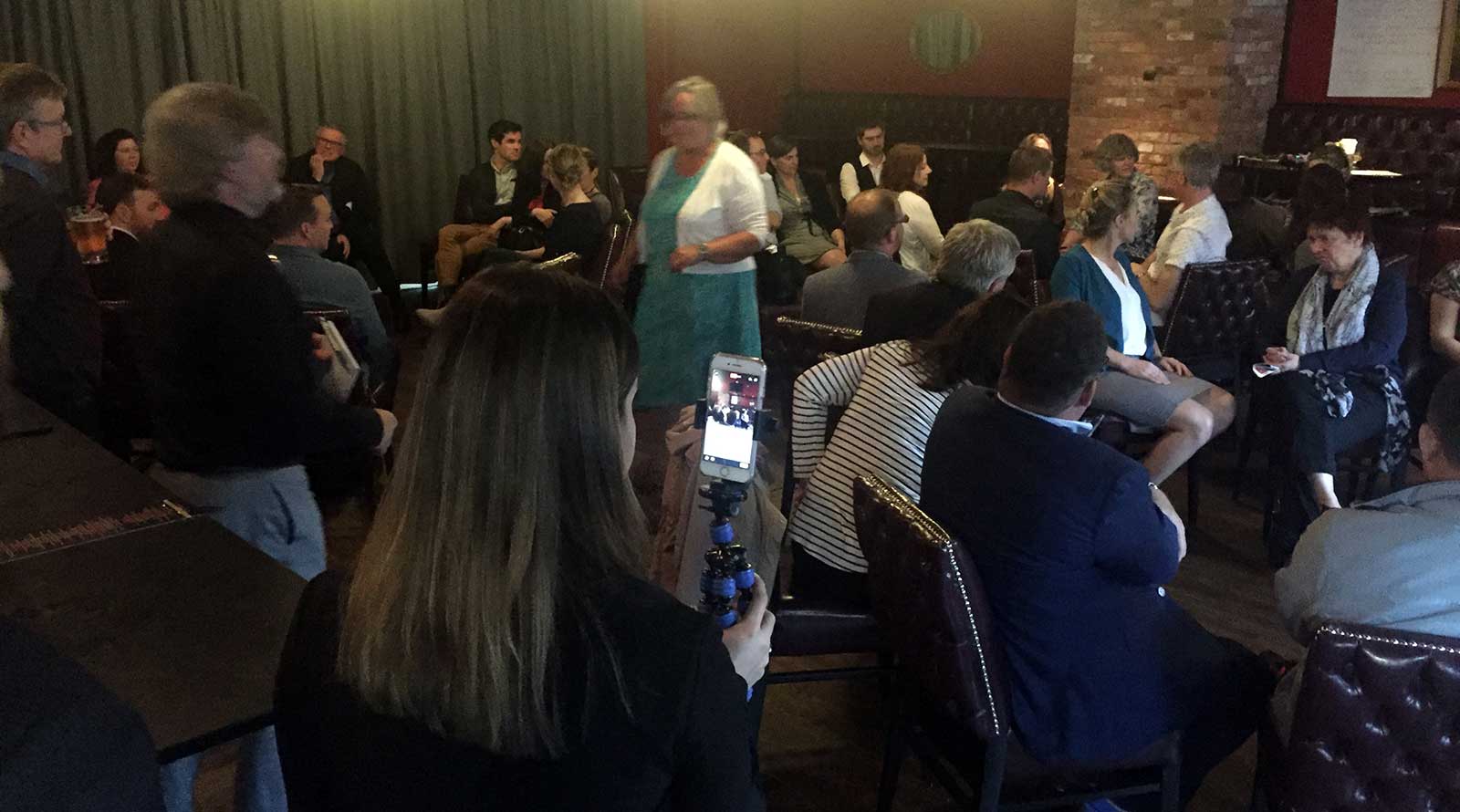Public engagement in the “Post-Covid” world: Step One – Planning
Public Engagement in the Post-Covid World
For over two years, the COVID-19 pandemic affected almost every aspect of our personal and professional lives. For public/stakeholder engagement professionals, the practice of public engagement may have changed forever.
Prior to the COVID-19 pandemic, geographic, mobility and other ability constraints were already preventing groups of stakeholders from being able to access open houses, town hall meetings and other venues of in-person public engagement. Today, of the citizens who were able to attend in-person public engagement opportunities prior to the COVID-19 pandemic, it seems unlikely that all will feel comfortable gathering in crowded community centres or hotel function rooms in the shadow of the pandemic – particularly for citizens that have health risk factors or live with those that do. Moreover, years of global pandemic living have shifted our behaviours, schedules and physical locations. Physical gathering places in urban areas that may have been easily accessible to those working in corporate office buildings are unlikely to be as accessible for those same individuals who are now permanently working from home.
Accordingly, digital public engagement is a crucial tool in the post-COVID public engagement toolkit that will ensure that a planned consultation will reach all targeted groups of stakeholders. Online public engagement offers the benefits of being highly cost-effective and widely accessible while still offering stakeholders and citizens real opportunities to provide meaningful input. If configured properly, digital engagements can be every bit as flexible, comprehensive and robust as in-person engagements, while significantly increasing reach and the number of participants. But care must be taken in designing, managing, and reporting on digital engagements if their full potential is to be realized.
In this blog series we’ll help you plan, build, promote and manage digital engagements. Digital engagements require the use of digital platforms, such as 76engage, through which organizations can connect with participants, listen to their goals, gather their input and collaborate on solutions. In this first of our planning blog posts, we cover the process of setting goals and reporting objectives.
Planning Part 1: Setting goals and reporting objectives

The first step to conducting any public engagement is to establish the goal of the consultation. The IAP2 Spectrum of Participation published by the International Association of Public Participation (IAP2) provides a handy chart to help you situate your engagement goal and understand the corresponding promise to the public. Knowing the goal and the promise will help you frame the engagement and choose the right tools. Many organizations that primarily used in-person public engagement tools (ex. open houses, town halls, door-knocking) prior to the pandemic switched to digital public engagement tools (ex. virtual town halls and online questionnaires, forums, and polls) during pandemic. These organizations are now grappling with the decision of where to go next: should they return to conducting solely in-person public engagement, continue conducting solely virtual public engagement or develop a hybrid strategy?
In-person, virtual or hybrid?
The decision of whether continued engagement is done solely online or in combination with in-person engagement should depend on who the target participants are for this particular consultation. For example, if your organization needs to obtain input from audiences with limited access to the internet (such as those living in rural or underserved areas), it is important that you also use in-person consultation tools. While COVID-19 made this nearly impossible for the past several years, we are now beginning to foresee a day when open houses and town hall meetings will return to the consultation landscape. If you are planning a consultation for a set of stakeholders that you’ve consulted with recently, now is a great time to take the temperature. Ask them how they would prefer to be consulted with (in-person, online or a mix of both) so that you can co-create this aspect of your organization’s engagement strategy.
Many organizations who experienced the pain points of switching from a purely in-person consultation strategy to a digital consultation strategy at the start of the pandemic are recognizing the risks of not maintaining some level of digital public engagement moving forward. While we hope to never experience a global crisis of the COVID-19 pandemic’s scale again in our lifetime, there are no certainties that another health or climate crisis will not drive the world to a halt again. Having an online public engagement strategy already established and digital infrastructure regularly being used as a tool in your organization’s engagement toolkit will make it much easier to rely on when needed.
One-off or ongoing?
Consider and define whether this a one-off engagement or the start of an ongoing relationship with your audience. For engagements that are intended to be part of an ongoing relationship, consider using an online public engagement platform. Online public engagement platforms (also known as “digital public engagement platforms”, “community engagement platforms”, “audience engagement platforms”) combine a collection of engagement tools under one roof. Online engagement platforms are ideal for ongoing engagements because they allow participants to join a digital space where they can build relationships with organizations over time.
As governments move towards more openness with open dialogue at the core of a citizen-centric government style, sustained and ongoing engagement will become the common ground where government and citizens will come together to discuss and make decisions. A key benefit of online engagement platforms is that they allow participants to track their engagement history overtime, see a record of their individual engagement and track topics that are important to them, creating a greater sense of participant ownership in the process. Additionally, online engagement platforms allow participants to maintain and update account profiles. These profiles contain information about their interests, allowing organizations to invite participants from past engagements to participate in new initiatives. These profiles can also contain demographic information, removing the need to ask for it over and over each time you run a new engagement.
What about privacy and data ownership?
With good reason, there is increased wariness about the state of online privacy. The COVID-19 pandemic required many workplaces to shift to remote work and many industries to move their services online, leading to a marked increase in the volume of data breaches and leaks of personally-identifiable information. A recent study by KPMG found that 68% of respondents were concerned about the level of data being collected by organizations and 40% don’t trust companies to use their data ethically.
The success of your consultations depends largely on the trust that participants have in the process. As the organization running the consultation, it is paramount that you ensure that participant data, particularly their personal information, is kept private and safe at all times. Make sure that the data is housed on secure databases located in the country where participants live.
In terms of data ownership, make sure that the company that provides you with the technology makes it clear that:
- you own all of the data;
- this data can be moved from the platform to other tools;
- they will never use any of the data for any purpose;
- they will delete and destroy all of the data following the termination of the contract.
Defining reporting objectives
When planning an online public engagement, think about how you will need to report the outcome of the engagement upfront. Having a clear idea about your reporting needs will ensure that you are asking the right questions from the start.
Knowing how you will want to break down the input, for example, across different demographic indicators, will help you determine which pieces of information you will need to collect from participants.
Tip: When we consult on online public engagement projects, we often see clients build out drafts of multi-page surveys with demographic questions placed at the very beginning of the survey. This often leads to higher drop-off rates. Unless used for screening, we recommend placing demographic at the end of a survey and instead, beginning the survey with questions about the topic that enticed the participant to click the link to take the survey. For example, if your organization has asked potential participants to take a survey about their recent experience with city parks in order to inform the design of new parks being built, consider starting the survey with a question like “What features are currently missing in your local park that you would like to see in a new park in the city?” rather than demographic questions.
As you identify your reporting objectives, you will be able to compile a list of what data points you require from participants. Once this list of data points has been identified, try not to ask for more information. Asking for the minimum amount of information possible will reduce participation barriers and increase the likelihood that participants hit the ‘submit’ button.
For more information on our state-of-the-art digital engagement platform, visit 76engage. Our next blog post digs into designing your engagement and preparing the content. Stay tuned.
Big claims are made about the future of artificial intelligence and machine learning – but your datasets are small. What does this mean for you?
In 2021, 76% of sampled enterprises have prioritized artificial intelligence (AI) and machine learning (ML) over other IT initiatives, according to a study by Algorithmia (Columbus, 2021). Despite increased spending on artificial intelligence and machine learning projects across industries, many organizations with small datasets are left wondering how they can leverage their existing datasets to implement these solutions.
For the purpose of analytics and prediction, machine learning solutions require high-quality, large datasets that can be used to train algorithmic models. Here, ‘high-quality’ and ‘large’ refer to data that is essential, diverse and representative for your project and that has undergone adequate feature transformation (formatting, cleaning, feature extraction). When we consider the size of a dataset needed to train a relatively simple model, Telus International discusses the ‘Rule of 10’:
“One common and much debated rule of thumb is that a model will often need ten times more data than it has degrees of freedom. A degree of freedom can be a parameter which affects the model’s output, an attribute of one of your data points or, more simply, a column in your dataset. The rule of 10 aims to compensate for the variability that those combined parameters bring to the model’s input.” (Telus International, 2021)
With datasets that are large enough, the effects of both bias and variance are minimized in models, empowering very different machine learning algorithms to perform virtually the same. This is a key driver for why companies like Google, Facebook, Amazon, and Twitter, are dominant in artificial intelligence research.
But what if your organization isn’t a tech giant with access to minute data from a user base of millions? What if your datasets are “small”? In this case, do machine learning and artificial intelligence solutions still have a role to play in your analytics strategy? The answer is yes, but with a little help. The following are some techniques that can be used to evade the small data challenge.
- Synthetic data generation: synthetic data tools are used to generate synthetic data to match the collected ‘real-world’ sample data, while ensuring that the sample data’s important statistical properties are reflected in the synthetic data. According to Gartner, 60% of the data used for the development of artificial intelligence and analytics projects will be synthetically generated by 2024 (White, 2021).
- Low-shot learning/Few-shot learning: low-shot/few-shot learning is a technique that enables a model to make a prediction based on a small number of training examples. In practice, a machine learning model may be given thousands of simple inspection tasks, each of which only has a small number of training examples. This enables the model to spot the most critical patterns since it only has a small dataset to draw from.
- Transfer learning: transfer learning is a technique that allows small datasets to be supplemented by storing knowledge gained while solving a related (but different) problem that ample data is available for. This knowledge is then applied to the small dataset model or problem. For example, knowledge gained while learning to identify trees could apply when seeking to identify shrubs.

Columbus, Louis. 76% Of Enterprises Prioritize AI & Machine Learning In 2021 IT Budgets. (2021). Retrieved from https://www.forbes.com/sites/louiscolumbus/2021/01/17/76-of-enterprises-prioritize-ai–machine-learning-in-2021-it-budgets/?sh=53ca5af2618a
Telus International. How much AI training data do you need?. (2021). Retrieved from https://www.telusinternational.com/articles/how-much-ai-training-data-do-you-need
White, Andrew. By 2024, 60% of the data used for the development of AI and analytics projects will be synthetically generated. (2021). Retrieved from https://blogs.gartner.com/andrew_white/2021/07/24/by-2024-60-of-the-data-used-for-the-development-of-ai-and-analytics-projects-will-be-synthetically-generated/
Quantity or quality of participation? You don’t have to choose.
What should you do? Require that users register to participate or allow anonymous submissions? That is the question. In traditional online community applications, systems ask users to log in or register upfront in order to participate. As we’ve seen, asking users to register before they interact, deters some users from participating. So you end up with fewer submissions. But you don’t have to go all the way to allowing anonymous submissions. There’s a better way to do this.
Infographic: Public engagement in the Canadian mining industry
Natural Resources Canada used 76engage to power their online consultations in support of the Canadian Minerals and Metals Plan. Read more to see an infographic of the early feedback received through the platform to-date.
Ongoing community engagement fosters trust and support for change
As more and more people have access to the Internet, the connected city of the future will unequivocally incorporate citizens’ input in everyday decisions. Therefore, organizations must encourage, promote, support and participate in active dialogue with the communities they serve.
On public engagement privacy, Cambridge Analytica, and user trust
Participants must feel at ease knowing that organizations will respect their privacy and protect their personal information. When trust deteriorates, participants will simply stop providing input.
Accessibility and the future of user interfaces
Visual interfaces are inherently deficient in addressing a visually-impaired audience. There is an argument to be made about embracing these limitations and seek solutions outside the CLI and GUI realms.
Online civic engagement and the digital divide
Governments are increasingly keen and open to listening to citizens through consultations and online civic engagement. A small set of data points by the Pew Research Center reminds us that while we are keen to include, the digital divide is still pretty much alive.
Improving the reach of public engagement
A recent IAP2 event got me thinking about why not more people participate in public engagement opportunities. One of the topics discussed was what could be done to get more people to participate in public engagement? The assumption was that even though some people do participate, more could be done to make engagements more inclusive.
If you promote it, they will come
We’ve all been there. We see a flyer on a street post inviting us to attend a town hall, only to realize that it happened last week. Or we made it to the event, but it was so crowded that the shy people at the back of the room, we didn’t feel confident enough to participate. All of this is gone when public engagement goes online.










Recent Comments